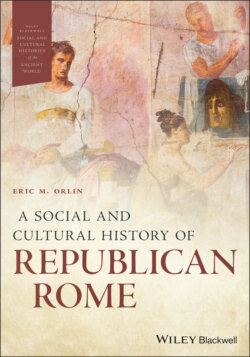Читать книгу A Social and Cultural History of Republican Rome - Группа авторов - Страница 25
Working with Sources
ОглавлениеBrutus in Bronze?
A bronze head found in the sixteenth century (Figure 2.1) tells us as much about how people have wanted to view the Romans as it does about the Romans themselves. From a purely aesthetic standpoint, we can appreciate the quality of the work and gain an insight into Roman art. The inlaid glass and bone eyes are original and can help us visualize the appearance of other statues where these materials no longer survive. The style bears similarities to Etruscan bronzes in technique and appearance, an indication of artistic links between the two cultures, while the seriousness of expression becomes a regular feature of Roman portraits. It is certainly one of the finest bronze sculptures to have survived from ancient Rome and a highlight of many visits to Rome.
Figure 2.1 So-called Capitoline Brutus, dated to the fourth or third century BCE, found in the sixteenth century CE. Musei Capitolini, Rome.
Problems arise when we try to ask questions about the statue, such as who it represents or when it was made, because do not know the exact provenance (find spot) of the head and so lack crucial information about it. The sculpture is known as the Capitoline Brutus because it was given to the Capitoline Museum in Rome in 1564. Already in the sixteenth century the head was already being identified as Brutus. The high cheekbones, beard, and stern expression were felt appropriate for a statesman, and the antiquarian aristocrats of the sixteenth century felt there was no better example of a Roman statesman than the founder of the Roman Republic. In a short time the statue became a symbol of liberty: it was actually carried off to Paris by Napoleon and then returned to Rome following Napoleon’s downfall.
There is, however, no firm evidence linking this portrait head to Brutus. Not knowing where the statue was found means we can only guess based on its appearance. Arguments about its identification as Brutus are based on comparisons to other objects such as coin portraits that have labels, but these assessments are often inconclusive. We do not even know whether the statue presented the figure as engaged in civic or military business; the togate chest and shoulders (known as the “bust”) suggest a civilian, but these were added to the head in the sixteenth century. Such reconstructions are common and often give a misleading impression of the original artwork, which is another problem that a modern scholar must confront.
Even the date of manufacture is uncertain. Most scholars believe that it dates from around 300 BCE, which would make it one of the oldest surviving bronze statues from Rome, but some have argued that certain features suggest it was made in the late second century and intentionally designed to have a “retro” look. These arguments again depend on subjective impressions. Knowing the archaeological context might enable us to answer this question. For instance, if it was found in a building dating to the third century, it cannot have been made 200 years later.
The information we can get from the Capitoline Brutus is thus highly limited. More than anything else, the bronze head illustrates the need for proper archeological excavation and documentation of ancient objects if we are to understand them and not just appreciate their beauty.
Using the dates traditionally assigned by Roman authors, the Republic began in 509 BCE and lasted for nearly five hundred years. We will have occasion to study this story, known as the Rape of Lucretia, more closely later (see Chapter 6), but even this brief summary is sufficient to reveal many themes that are important to understanding the Roman Republic:
An almost obsessive hatred of one-man rule. Kingship was viewed by the Romans as a form of slavery, because as absolute rulers, kings could order others to do their bidding. Furthermore, because kings made the laws, there was no recourse when they committed misdeeds. The Roman elite wanted to promote the notion that they were all equal and that government was a public thing, not a private possession.
An emphasis on honor. Men believed that their honor was connected both to their military accomplishments and to the chastity of the females in the family, though we should note that women’s own views are harder to detect.
An openness but also a wariness about foreigners. The Romans were more generous with citizenship than many other ancient societies and frequently integrated foreign customs into their own behavior, but they could also display a violent xenophobia.
Frequent military warfare. Roman men of all social classes were frequently away from home on campaign, leaving women at home to manage their households on their own.
With these themes in the front of our minds, we are ready to embark on a brief tour of Roman history, to gain a familiarity with key figures and an understanding of the key events that shaped social and cultural developments throughout the Republic.
